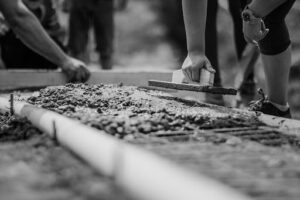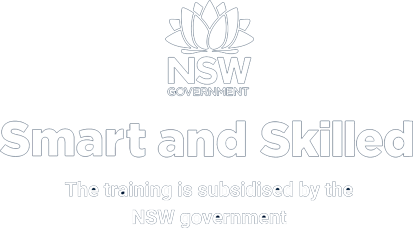Hello Workshopers and welcome to the 4th episode of The Workshop! Tools down, grab some smoko, sit on the Eskis and bring them a little bit closer. We have an amazing episode for you today. For those that don’t know him he’s not Stark. He’s all brick and block. Paul Neeson from the Perth campus. Paul, how are you?
Not too bad James, how are you today?
I’m doing very well. Paul obviously been super busy this week being O week.
Yeah, it’s true. We’ve had the orientation this week. We’ve had quite a big intake, to be honest. So quite a bit of work involved. And yeah it went well, we had a good team, which is pretty awesome. To be honest. We’ve got them all through. Looking forward to the big start next week.
Excellent. Paul, tell me a little bit. How did you get started in bricks?
Okay, I should say because I’m going on a bit. Once upon a time when I was just a young lad. I had a couple of friends a couple of years older than me. They were actually bricklayers at the time. And they asked me if I would try labour involved. And I started labouring and never turned back since to be honest, love labour. And I did it for a few years. Really happy, just wanted to take it a bit easier because at the time labouring was really hard. You didn’t have really you have forklifts and stuff like that. So when a truck turned up, you’d have to unload it all by hand. And as a labourer that’ll be part of your jobs. You don’t load everything by hand. Anything needed to go on a scaffold, you used to have a hod, so you’d fill the hod up, put it on your back, and you’d be up and down the ladder all day, every day. You’d have your mud, you’d have your bricks, you’d have your blocks, everything. There’s no mechanical help whatsoever. It’s quite a tough job at the time, though. I thought to myself ‘Now who am I taking it a bit easier’. So instead of doing this all day, I can just stay in one spot, even though you still lifting the weight, you’re not doing quite so much. So I’ll be a bricklayer!
Fantastic. So we’ve started your journey from labouring to bricks. How did you start? Was it for you an apprenticeship?
Yeah, I’ve always been like, physical work wise, and just married up really well for me. I just loved it. I never looked back. Never look back.
What were some key things that you learned during that apprenticeship?
Again, back then, we did everything from the footings to the roof. There wasn’t anything I wasn’t involved in it. We poured a concrete, we’d dig the footings. We’d actually dig the footings because it was on the JCB. So we dig the footings with pour the concrete, we’d put a floor in, we put the footings in, we build the house because obviously in the UK it’s all houses, not many bungalows. There is now, back then there wasn’t. And we even did tiling, plaster boarding. Helped put them many times, we put the rooms on ourselves. So I pretty much did everything in the building trade. So it was all varied. Now, if you’re a bricklayer, it’s a Brick lay. You don’t get involved in the other stuff, really. But I was lucky. I was involved in all, I just enjoyed it. And in fact, as time went on, and you got your trades where they said, Okay, this is carpenters job, leave them alone, kind of thing. I had less work to do. So it made even better. Yeah, no, it’s just been an enjoyable job since I’ve had tried other things. But you always end up going back to the brick lay.
So for you your trade was essentially something that you would always lean back on.
Yeah. And that’s a good thing. Because once you know what you’re doing, you’ve got a good knowledge of it. And then it all depends how much you love doing your job, because you only learn what you want to put into it. And I just enjoyed all of it. So I could walk away from it. But if I ever wanted to go back, I’ve always had the knowledge there. So it’s easy for me. I’ve always had a bit where I’ve trained people all throughout my life. So when I started doing work at Everthought it just felt like a natural progression.
That’s brings me on to my next question. How did you go from obviously your apprentice bricklayer in the UK? And then how did you find yourself down on the Western Australia Perth teaching at Everthought Education?
It sounds strange, doesn’t it? It’s just pretty simple really, dived in Brick Lane and about 20 years ago, I was with my then girlfriend and we decided we had enough of where we were and we wanted to try something different. We actually thought about moving to Canada. Now, we didn’t go to Canada in the end, because I thought to myself, yeah, how cold it is there because it’s really cold in the winter there. And I thought I’m gonna lay bricks in Canada. Yeah. And then the other option was Australia. And I thought, okay, at least it’s warm in Australia all the time, pretty much so I won’t have to worry about having days off and earning money. So we applied, they said it was it could take a couple of years. But we started, I applied in to be a bricklayer and started filling out the forms and everything in September. Then two days before Christmas, that same year, we’ve been accepted. We’ve got the visas, permanent resident visas, for Australia. So okay, yeah, so we came over to Australia. And just to do a couple of little hoops to jump through, and I got my GST and my tax file number and all the rest of it, and then jumped into Bricklaying.
So you basically you followed a very similar journey to our international students, but coming in via the visa route, and then become being a bricklayer in Australia.
Yeah, the only difference was I already knew what to do, where our students had been trained to do that. But yeah, I worked in different parts of the world anyway, so I’ve done some work in America, I’ve done some work in Ireland, and France, a couple of other places, Crete sort of done bits everywhere, but it’s just like a passionate thing. I love working with people. I love to have a bit of fun. And I really enjoy showing people what I’ve learned. Because there’s easy ways of doing stuff. I try not to make anything hard. Just make it as easy as possible. I’m a simple kind of guy in that way, James.
So you’ve studied with your ABN, and I guess your own business?
Not really I just went into working for people.
Okay, contracting.
Yeah. Because I didn’t want the headaches of people not paying and running around trying to find jobs all the time, it was just an easy thing to fall into straightaway, people are straight to talk to you straight down the line. And it’s just like you standing, it’s enjoyable, you have fun. At the end of the week, beer o’clock. And then obviously, I was working in the building right up until July last year, and there was a notice it was an ad. And I thought, well, I’ll just ring up and see about it. I didn’t think for a second I was gonna get it, I’ve been in a bricklayer for so long. And I was so lucky with the way the Everthought staff treated me, it wouldn’t be just me, I’m sure other people that, you know… they realise that you had a potential and they gave me the chance. I enjoy the people to work with. And how could I be upset or complain? When you’ve got people who have actually gone out of the way to look after you and actually not only looked after you, but spent money to help you? It’s pretty amazing. To be somewhere where people actually give a damn about you, and actually putting money where their mouths are as well. Amazing. Amazing.
Paul, what are some things that you’re trying to instil in your students currently?
Okay, what am I trying to do is I want them to feel like this is the most realistic thing to Bricklaying they are going to get. I teach them every… pretty much a lot of… can’t say everything because there’s a lot of years, but I tried to teach them the best ways of doing things. I break things down for them, where you see a project and it can be overwhelming. But if you break that down into little sections, it’s not that scary. And I tried to show them ways of making things easy for the sales were not actually working harder, but they’re actually doing more work. It’s just little tricks, and do the faces on the students when you show them something so basic, but it helps them so much. And their eyes open up. It’s amazing. The big difference is now because we’ve got all power saws and angle grinders, all the rest of it. When I did all my stuff, there was no such thing as that. I had to… if we did an archway, I would cut the bricks with a brick hammer or a hammer and a bolster. And it’s still like to look as nice as it would if it had been cut by someone. But back then we didn’t have anything like that. Not only do I get the students to use the power tools, obviously, I tried to get them to use old school ways as well, because you’re not going to have that on every single job and you’re not going to have that, especially working for yourself, you’re not going to be able to afford all the expensive equipment. They need to know these things. And it’s the same as sneaky ways of doing your gauge, like I get a spirit level and I’ll mark the gauge of the spirit level. So every time you plumb the wall, you’ll have a line there and you’ll see your line and if your brick works touching that line, you know it’s going up gauge, and it’s just a simple thing. But look how much time it saves you. You don’t have to go and get a tape measure. You don’t have to try to work out and measurements in your head all the time. It’s there. It’s just little tricks, little tricks, and it’s just great.
Okay, so what are some characteristics that you think makes a good bricklayer?
Passion. You got to love it, you’ve got to love it. If you love what you do, especially bricklaying, you will be good at the job. If you’re just doing it. It doesn’t matter if he was here for 10 years, you’ll never be a good bricklayer, you just haven’t got the passion for it. And I want to insist on, the guys that I train is to be good at what they do, I don’t want them to rush and feel like they’ve got a rush job, I want you to take your time, because you think yourself, what’s quicker, taken another hour or two hours to build a wall that looks amazing, or rushing and that will have to come down because it made a bit of a mess of it. And when you make them understand that, they think, ‘oh yeah, if I didn’t have to take this… if I’d have to take this down, I would lost a day. But that makes for a couple hours where they made a good job and just check it, all checked it, it’s done straightaway first time.
So for students that are assessing themselves across multiple trades at the moment and maybe they haven’t tried bricklaying, haven’t had the opportunity of an Australian domestic try-a-trade Certificate II or even an apprenticeship, what sort of other things would make, in your opinion, a good bricklayer? So if you don’t know if you’ve got the passion for it…
As a kid, if you like Lego or Mecano, you’re probably on your way, there’s something inside you that says ‘this is what I want to do’. And let’s face it, out of all the trades Bricklaying is the best.
So what are some sort of real life projects that students will get to work on when they join your class?
Okay, like I say I want it to be as realistic as possible. So we will build walls, cavity walls, we do veneers, we actually do some different bonds like a Flemish bond and an English garden wall bond. Just stuff that you’ll actually use these in real life. Like in real life, if you build somebody a garden wall, there’s a good chance it’s going to be a English bond. So we want people to learn how to do it. And even when we do it, instead of using a saw, I’ll show him how to cut the bricks with the hammer and bolster. So it’s easy. And we also do chimneys. We do put you on flashings around and so you understand why you got to put flashings on and damp proof courses. You know, one of the final things we have to do is a fireplace. But as you can imagine in Australia, there’s not many fireplaces, it’s more of an English kind of thing. But I don’t treat that as it’s okay, we’re building a fireplace I just treated as this is a complicated bit of work, with a lot of a lot of problem points and angles and it helps you with your skills. Because the more skilful you are, the easier things are going to be for you!
Material. I know that we’ve spoken quite passionately about between it between you and me about using high quality local source materials. What materials do you guys use?
If you’re using stuff that is messed up or whatever… How can you do a nice job because you don’t even know if at the end of the day it will actually sell because it’s a mess. But if you’ve got the high quality stuff, it gives you the incentive because you it looks nice when it’s clean. And it makes you try harder. Now, also, when you’re using stuff what’s already been used, like for a block for example, you’ve got all holes in blocks, now they get filled up with mud. So essentially, when you lay that block again, it’s like putting a solid brick down or solid block down. And it’s completely different to how a block would lay normally A solid block compared to a normal block, it’s completely different. It’s hard to believe that using new stuff, overall all stuff, makes a massive difference. And I’m sure anybody who lays bricks would be able to tell you that. And you know, what a difference!
So you’ve travelled the world. You’ve worked in the UK, France, Crete and Australia. How would you adapt them into your course? And also how do you obviously treat that with maintaining to the Australian Standard?
Okay, the main difference and main thing that I found was different to anywhere else is Australians for example, you’d like to lay bricks, third bond. Where in England and most other places… also in Brisbane they use a lot of H blocks. So how you lay them out on a H block is completely and totally different to what they would do anywhere else on any block. So as it happens, we have H blocks and I teach them how to lay them as well and get it to the know how to scoop them all up on a trowel and actually put it onto the blocks, which is quite interesting. And it’s also in Brisbane, there’s a lot of veneer houses. There’s a few in Western Australia but not so many. But in Brisbane, there’s a lot of veneers, so it’s good for them to learn how to do veneer work.
Oh you do veneers as well?
Yes! So we try to do as many types of different brickwork as there is, because one day they’re gonna come across it.
So when you see a student struggling, and… what do you do to try and turn that around and get them to where they need to be?
Hit the positives! Don’t tell them the bad things, tell them the good things they have done. If they hit a wall, it might not be plumb, but the big work might be staggered properly. So you start telling them all the good things – go “Okay, this isn’t quite right. But what we’ll do is, we’ll do it again, we’ll just keep your eye on the level a bit more.” So you don’t have to be negative about it, the worst thing is being negative, because that makes it so people don’t want to try. If you give them the positives, then they think, “Oh, I did all this, right, I’ve only got to do that really, and it’d be really good.” But if you just go in, say no, being negative straightaway, “what you’re doing, this is terrible”, you wouldn’t want to carry on, it just depresses you, doesn’t it, you just think what’s the point. But when you think that you’ve done so much, and there’s only a tiny bit you need to do to make it better, it’s a big difference. And I try to do that all the time with all of them. And I don’t let people go behind, I always make an effort to make everyone take the time, really take the time. So where you might have somebody who can go a lot quicker, I slow everybody down, because I want the brick work to look as nice as possible. Because speed always comes. If you’re good brick layer and you get fast, you’re still a good brick layer. But if you’re a bad brick layer, who tries to go fast, you are bad brick layer that goes fast, and you can never change that. So I tried to get set in a mind straightaway, but in a good way.
So in your classroom, you try and create a positive feedback environment?
I try to make it as realistic as possible to be on a building site. We have a lot of fun. I encourage people to have a laugh. It’s having the attitude towards the job and being able to talk to people and having the confidence and that’s what I tried to install as well. Have the confidence. If something’s wrong, talk, speak up. And when they do, I congratulate them. And I’m over the moon for everyone in the industry doing exactly the right thing. Never be afraid to say this too, honestly. Because it’s down to you. If you’re working with somebody, and they’re doing a bad job, but you’re doing a good job… you shouldn’t be afraid to say something. Because you’re guaranteed that person doing a bad job wouldn’t be afraid to let you fall on the sword over it. And that’s not fair. So I try to install that gives you the confidence. If someone’s not right, speak up.
What advice would you give to someone that was considering your Cert III in Brick and Block?
I’ll be honest, it will be the best choice in your life. You work with a lot of good people, every student in my class you can talk to and have fun with and they’re there to help you. I’ve made sure that everybody is a team player and you can get on everyone. You’d love it. It would be the best choice of your life – much better than carpentry, much better than tiling. Be a bricklayer. And I’d encourage any girls out there. If you ever think about doing Bricklaying, do it. Because there’s not many women bricklayers out there. And you can make a big difference.
Massively. I actually find that the girls do some amazing work. I think their eye for detail over the boys is what sets them apart.
I agree, because it’s not as hard as you think it is. It’s all to do with your mindset and how you work things out. And I’ll give you the mindset, I’ll show you how to make things easy for yourself. And you’ll find that there’s a niche thing out there for women as bricklayers. And you’d go a long way.
I love it. I think that’s where we should end.
Oh, I was enjoying this James!
Guys, that’s the end of episode 4, and the end of our trainer showcase at Everthought. So I want to thank everyone for listening and we will see you next time.





